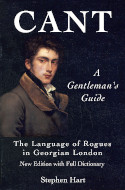THE HERCULES' PILLARS TAVERNS
Hercules Pillars Alley, on the south side of Fleet-street, near St. Dunstan's Church, is described by Strype as "altogether inhabited by such as keep Publick Houses for entertainment, for which it is of note."
The token of the Hercules Pillars is thus described by Mr. Akerman:—"ED. OLDHAM AT Y HERCVLES. A crowned male figure standing erect, and grasping a pillar with each hand.—℞. PILLERS IN FLEET STREET. In the field, HIS HALF PENNY, E. P. O." "From this example," illustratively observes Mr. Akerman, "it would seem that the locality, called Hercules Pillars Alley, like other places in London, took its name from the tavern. The mode of representing the pillars of Hercules is somewhat novel; and, but for the inscription, we should have supposed the figure to represent Samson clutching the pillars of temple of Dagon. At the trial of Stephen Colledge, for high-treason, in 1681, an Irishman named Haynes, swore that he walked to the Hercules Pillars with the accused, and that in a room upstairs Colledge spoke of his treasonable designs and feeling. On another occasion the parties walked from Richard's coffee-house[34] to this tavern, where it was sworn they had a similar conference. Colledge, in his defence, denies the truth of the allegation, and declares that the walk from the coffee-house to the tavern is not more than a bow-shot, and that during such walk the witness had all the conversation to himself, though he had sworn that treasonable expressions had been made use of on their way thither.
"Pepys frequented this tavern: in one part of his Diary he says, 'With Mr. Creed to Hercules Pillars, where we drank.' In another, 'In Fleet-street I met with Mr. Salisbury, who is now grown in less than two years' time so great a limner that he is become excellent and gets a great deal of money at it. I took him to Hercules Pillars to drink.'"
Again: "After the play was done, we met with Mr. Bateller and W. Hewer, and Talbot Pepys, and they followed us in a hackney-coach; and we all supped at Hercules Pillars; and there I did give the best supper I could, and pretty merry; and so home between eleven and twelve at night." "At noon, my wife came to me at my tailor's, and I sent her home, and myself and Tom dined at Hercules Pillars."
Another noted "Hercules Pillars" was at Hyde Park Corner, near Hamilton-place, on the site of what is now the pavement opposite Lord Willoughby's. "Here," says Cunningham, "Squire Western put his horses up when in pursuit of Tom Jones; and here Field Marshal the Marquis of Gransby was often found." And Wycherley, in his Plain Dealer, 1676, makes the spendthrift, Jerry Blackacre, talk of picking up his mortgaged silver "out of most of the ale-houses between Hercules Pillars and the Boatswain in Wapping."
Hyde Park Corner was noted for its petty taverns, some of which remained as late as 1805. It was to one of these taverns that Steele took Savage to dine, and where Sir Richard dictated and Savage wrote a pamphlet, which he went out and sold for two guineas, with which the reckoning was paid. Steele then "returned home, having retired that day only to avoid his creditors, and composed the pamphlet only to discharge his reckoning."
[34] Subsequently "Dick's."
John Timbs
Club Life of London Vol. II
London, 1866

